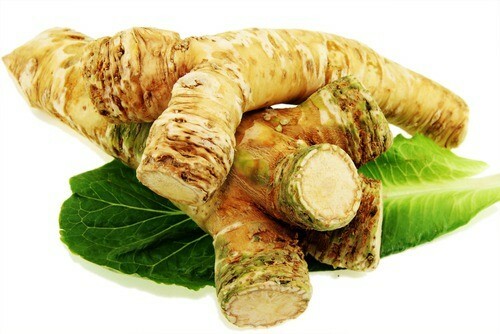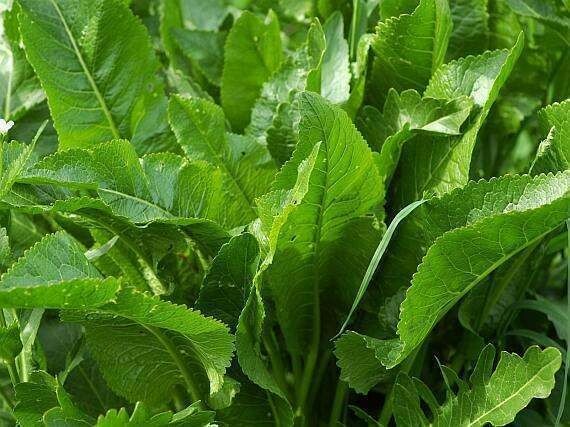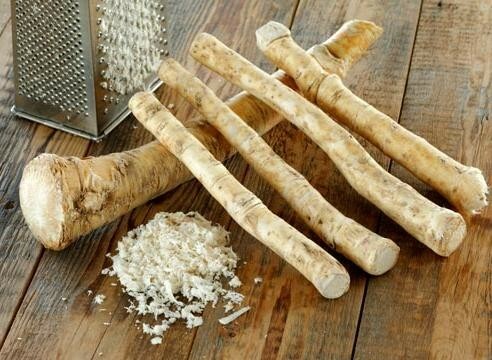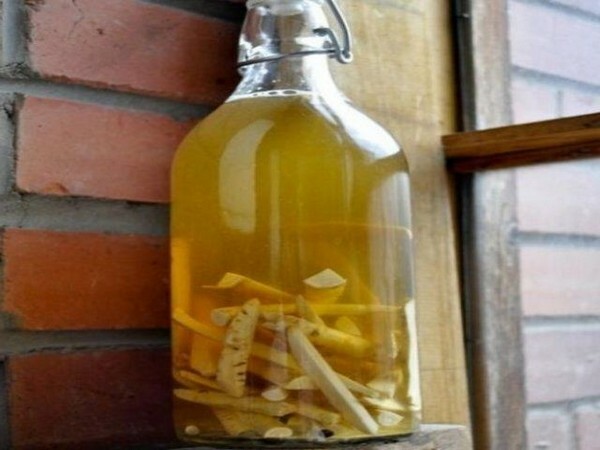Contents:
- Curative properties of horseradish
- Principles of gout treatment
- Use of horseradish in treating gout
Horseradish or rustic - a perennial herb native to southern Europe. Almost everyone as a culinary seasoning, having a specific acute and burning taste, knows its root. It is added to dishes from meat, fish, vegetables, pickles and marinades. Horseradish is valued not only in cooking, but also in folk medicine, and in some European countries( France and Bulgaria) it is officially recognized as a medicinal raw material. The leaves and roots of this plant contain a large number of useful compounds and are used to treat many diseases. Compresses, baths, applications on their basis are very effective for pain in the joints caused by chronic inflammatory and degenerative pathologies or metabolic disorders. Traditional healers have long been using horseradish for gout, arthritis, arthrosis, rheumatism, radiculitis and other problems of the musculoskeletal system.

Healing properties of horseradish
The use of horseradish, like any other plant, in folk medicine is due to its useful properties. First of all, it is a valuable source of vitamins and minerals. The plant contains vitamins of group B( pyridoxine, folic acid, thiamine and riboflavin), vitamin A, E and C, and the concentration of vitamin C in it is comparable with orange, grapefruit and lemon.
Mineral composition is represented by the following list: iron, phosphorus and calcium, aluminum, potassium and sodium, manganese, sulfur, chlorine and copper. Fresh lime juice contains enzyme lysozyme, which has a pronounced antibacterial activity, which is realized due to hydrolysis of the most important component of the cell wall of peptidoglycan bacteria. Also in the horseradish were found flavonoids, phytoncides, organic and fatty acids, resins, proteins and carbohydrates.
Interestingly: In all parts of the plant in different quantities contain essential oils, which cause its specific rather sharp and burning flavor. The yield of essential oil from horseradish roots is 0.05%, its main component is allyl mustard oil.
In folk medicine as a medicinal raw material, roots, leaves and horseradish seeds are used. They have the following therapeutic effect:
- reduces blood sugar;
- stimulates intestinal motility and secretory activity of the digestive glands;
- facilitate the passage of thick sputum when coughing;
- dilute bile and facilitate its outflow;
- promote the healing of wounds and the destruction of pathogenic bacteria in them;
- improve metabolism;
- have a diuretic effect;
- helps to cleanse the body of toxins and toxins;
- have a bactericidal, antiviral and anthelmintic effect.

Means based on this plant are effective in diseases of the digestive system and respiratory organs, can be used for the prevention of influenza and colds. When topically applied, they have an irritating, distracting and warming effect, improve blood circulation, relieve inflammation and swelling. It is thanks to these features that lotions, compresses, applications of leaves and horseradish roots help with gout, arthritis, arthrosis, rheumatism and other diseases of the musculoskeletal system.
Principles of gout treatment
Gout refers to diseases caused by metabolic disorders. With this pathology, the body accumulates salts of uric acid( urates) and reduces their excretion by the kidneys. As a result, their concentration in the blood increases( over 420 mmol / L for men and 360 mmol / L for women), they begin to be deposited in bones, joints, cartilage tissue, tendons. So-called tofusy or gouty nodes are formed, which are dense nodules that are localized near the joints, in the auricles and in severe cases in internal organs. The presence of such nodes in the joints leads to a limitation of their mobility and causes severe pain. The course of gout is characterized by periodic attacks, which manifest themselves as the following symptoms:
- inflammation of one joint early in the morning or at night;
- sharply occurring pressing pain in the joint;
- swelling and fever in the area of the affected joint;
- redness of the skin;
- reduction of pain during the day.
Treatment of gout, as well as many other joint diseases, is aimed primarily at stopping the development of the pathological process and the removal of painful symptoms in the period of exacerbations. Given that the salts of uric acid are the products of the breakdown of the incoming proteins, the diet has a great importance for reducing their concentration. Meat, fish and broths from them, by-products, legumes, spices and other products are limited in the diet. Drug therapy includes drugs that inhibit the synthesis of uric acid and accelerate excretion from the body. During attacks, anti-inflammatory drugs of local and systemic action are prescribed.
Important: During a gout attack, the patient's joint needs complete rest.

In the complex treatment of the disease for a long time folk remedies have been used, one of which is horseradish. From the root of horseradish with gout prepare infusions for internal use, and from leaves and roots make compresses on sore spots, tinctures and solutions for rubbing. These drugs help to remove inflammation and pain, improve blood circulation and promote the excretion of salts. When gout is important to provide a plentiful drink, which will accelerate the leaching of urates from the body. Instead of regular water in the absence of contraindications, you can drink water, infused with horseradish. For this, several pieces of the cut root are placed in a container of water.
Use of horseradish in the treatment of gout
When treating gout with horseradish, the leaves and roots of the plant are mostly fresh. If there is no possibility to get them, it is allowed to take raw materials in a dried state. In this case, the dried root is first rubbed on a grater and steamed in water. Harvested and dried leaves of horseradish during gout are used for medicinal purposes in the winter, for this they are filled with boiling water before use.
Recommendation: Rub the fresh root of the horseradish in a well-ventilated area, as its aroma is very corrosive, causes pain in the eyes and irritates the nasal mucosa.
It should be borne in mind that when stored, horseradish quickly loses its healing properties. If the recipes suggest using a fresh grated root, then to obtain the maximum therapeutic effect, use it for the intended purpose immediately.
Leaf compress
Freshly picked leaves of the plant( 1 - 2 pieces) are covered with boiling water and applied to the diseased joint by the underside of the leaf to the skin. On top wrapped in polyethylene and insulated. Such a pack of horseradish with gout is done before bed and left for the whole night. The recommended course of treatment is 10 procedures.
Compress from the root of
There are many recipes for preparing compresses for joint pains from the root of horse radish. It can be used alone or add medicinal plants that have a similar effect.
Effective with gout is the following recipe. The ground roots of the plant( 2 tablespoons) are boiled( 200 ml).In the resulting broth, place a piece of linen cloth, lightly squeeze it, spread the steamed roots on it and apply a compress to the sore spot, fixing the food film on top. A similar compress is done without brewing, but simply wiping the root on a grater and laying on cotton fabric or folded several times gauze.
For pain in joints with gout to problem spots, also apply gruel from grated horseradish, top wrap it with leaves of mother-and-stepmother or burdock and fix with bandage. This compress reduces pain and helps dissolve urates and reduce tophi.
Rubbing horseradish tincture
Chopped horseradish root( 150 g) is poured with 5000 ml of alcohol, insist for 24 hours, periodically mixing. The received tincture is rubbed into sore spots, after the procedure is warmed with a woolen cloth.
Rubbing can also be done using freshly squeezed root juice, diluted with half of water.

Means for internal use
For gout, horseradish is also ingested in the form of infusion, a mixture of honey or freshly squeezed juice. To get the present 1 tsp.root horseradish rubbed on a grater, pour a glass of cold water and insist 10 hours. Drink this infusion in small portions throughout the day. Effective when gout is a combination of horseradish with honey. For people suffering from gout, before meals, it will be useful to use a mixture prepared from 10 grams of horseradish and 12 g of honey, or a mixture of 1 tsp.freshly squeezed root juice with 1 tsp.honey.
Warning: Internal use of horseradish is contraindicated in inflammatory processes in the gastrointestinal tract, hyperacid gastritis, liver, kidney and hypertension.
